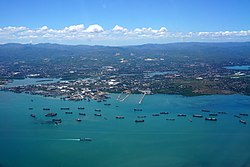This article needs additional citations for verification .(April 2013) |
Consolacion Kampi-ig | |
|---|---|
| Municipality of Consolacion | |
 Shipyard in Consolacion | |
| Anthem: "Consolacion, O Lungsod Nga Matahum" | |
 Map of Cebu with Consolacion highlighted | |
 Interactive map of Consolacion | |
Location within the Philippines | |
| Coordinates: 10°24′N123°57′E / 10.4°N 123.95°E | |
| Country | Philippines |
| Region | Central Visayas |
| Province | Cebu |
| District | 6th district |
| Founded | 1871 |
| Reestablished | 1920 |
| Barangays | 21 (see Barangays) |
| Government | |
| • Type | Sangguniang Bayan |
| • Mayor | Teresa P. Alegado |
| • Vice Mayor | Aurelio A. Damole |
| • Representative | Daphne Lagon |
| • Municipal Council | Members |
| • Electorate | 100,189 voters (2025) |
| Area | |
• Total | 37.03 km2 (14.30 sq mi) |
| Elevation | 26 m (85 ft) |
| Population (2024 census) [3] | |
• Total | 153,931 |
| • Density | 4,157/km2 (10,770/sq mi) |
| • Households | 36,620 |
| Economy | |
| • Income class | 1st municipal income class |
| • Poverty incidence | 18.72 |
| • Revenue | ₱ 671.2 million (2022) |
| • Assets | ₱ 1,932 million (2022) |
| • Expenditure | ₱ 177.7 million (2022) |
| • Liabilities | ₱ 462.4 million (2022) |
| Service provider | |
| • Electricity | Visayan Electric Company (VECO) |
| • Water | Metropolitan Cebu Water District (MCWD) |
| Time zone | UTC+8 (PST) |
| ZIP code | 6001 |
| PSGC | |
| IDD : area code | +63 (0)32 |
| Native languages | Cebuano Tagalog |
| Catholic diocese | Archdiocese of Cebu |
| Patron saint | Narcissus of Jerusalem |
| Website | lguconsolacion |
Consolacion, officially the Municipality of Consolacion (Cebuano : Lungsod sa Consolacion; Tagalog : Bayan ng Consolacion), is a municipality in the province of Cebu, Philippines. According to the 2024 census, it has a population of 153,931 people. [5]
Contents
- Etymology
- History
- Geography
- Barangays
- Climate
- Demographics
- Economy
- Infrastructure
- Utilities
- Education
- Culture
- Sarok Festival
- Notable personalities
- References
- Sources
- External links
Consolacion is bordered on the north by the town of Liloan, to the west by Cebu City, on the east by the Camotes Sea, and on the south by the city of Mandaue. It is 12 kilometres (7.5 mi) from Cebu City and 5 kilometres (3.1 mi) from Mandaue.



